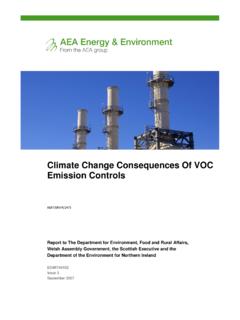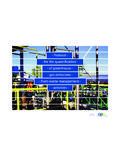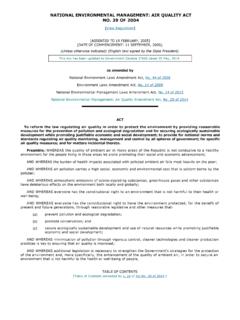Transcription of OECD Environmental Outlook to 2030
1 OECD Environmental Outlook TO 2030 ISBN 978-92-64-04048-9 OECD 2008 1 OECD Environmental Outlook to 2030 Summary in English How will economic and social developments drive Environmental change to 2030? What policies are needed to address the main Environmental challenges? How can OECD and non-OECD countries best work together to tackle these challenges? The OECD Environmental Outlook to 2030 provides analyses of economic and Environmental trends to 2030, and simulations of policy actions to address the key challenges. Without new policies, we risk irreversibly damaging the environment and the natural resource base needed to support economic growth and well-being. The costs of policy inaction are high. But the Outlook shows that tackling the key Environmental problems we face today -- including climate change, biodiversity loss, water scarcity and the health impacts of pollution -- is both achievable and affordable.
2 It highlights a mix of policies that can address these challenges in a cost-effective way. The focus of this Outlook is expanded from the 2001 edition to reflect developments in both OECD countries and Brazil, Russia, India, Indonesia, China, South Africa (BRIICS), and how they might better co-operate on global and local Environmental problem-solving. OECD Environmental Outlook TO 2030 ISBN 978-92-64-04048-9 OECD 2008 2 KEY MESSAGES The OECD Environmental Outlook to 2030 is based on projections of economic and Environmental trends to 2030. The key Environmental challenges for the future are presented according to a traffic light system (see Table 1). The Outlook also presents simulations of policy actions to address the key challenges, including their potential Environmental , economic and social impacts. Table 1. The OECD Environmental Outlook to 2030 [Green Light] [Yellow Light] [Red Light] Climate change Declining GHG emissions per unit of GDP Global GHG emissions Increasing evidence of an already changing climate Biodiversity & renewable natural resources Forested area in OECD countries Forest management Protected areas Ecosystem quality Species loss Invasive alien species Tropical forests Illegal logging Ecosystem fragmentation Water Point-source water pollution in OECD countries (industry, municipalities)
3 Surface water quality and wastewater treatment Water scarcity Groundwater quality Agricultural water use & pollution Air quality OECD country SO2 & NOx emissions PM & ground-level ozone Road transport emissions Urban air quality Waste & hazardous chemicals Waste management in OECD countries OECD country emissions of CFCs Municipal waste generation Developing country emissions of CFCs Hazardous waste management and transportation Waste management in developing countries Chemicals in the environment and in products Source: KEY: Green light = Environmental issues which are being well managed, or for which there have been significant improvements in management in recent years but for which countries should remain vigilant. Yellow light = Environmental issues which remain a challenge but for which management is improving, or for which current state is uncertain, or which have been well managed in the past but are less so now.
4 Red light = Environmental issues which are not well managed, are in a bad or worsening state, and which require urgent attention. All trends are global, unless otherwise specified. Action is affordable: policy scenarios and costs The Outlook highlights some of the red light issues that need to be addressed urgently. The policy scenarios in this Outlook indicate that the policies and technologies needed to address the challenges are available and affordable. Ambitious policy actions to protect the environment can increase the efficiency of the economy and reduce health costs. In the long term, the benefits of early action on many Environmental challenges are likely to outweigh the costs. OECD Environmental Outlook TO 2030 ISBN 978-92-64-04048-9 OECD 2008 3 As an example, a hypothetical global OECD Environmental Outlook (EO) policy package (EO policy package, see Chapter 20) was applied.
5 It shows that, by combining specific policy actions, some of the key Environmental challenges can be addressed at a cost of just over 1% of world GDP in 2030, or about percentage points lower average annual GDP growth to 2030 (Figure 1). Thus world GDP would be about 97% higher in 2030 than today, rather than nearly 99% higher. Under such a scenario, emissions of nitrogen oxides and sulphur oxides would be about one-third less in 2030 while little change is projected under a no-new-policy baseline scenario, and by 2030 growth in greenhouse gas emissions would be contained to 13% rather than 37%. More ambitious policy action than the EO policy package would be needed to stabilise greenhouse gas concentrations at the levels being considered in international discussions (Figure 2). Another simulation was run of policies needed to stabilise atmospheric concentration at 450ppm CO2eq, one of the most ambitious targets being discussed.
6 The simulation shows that to reach this target, actions by all countries are needed to achieve a 39% reduction in global greenhouse gas emissions by 2050 relative to 2000 levels (Figure 3). Such action would reduce GDP by and below Baseline estimates in 2030 and 2050 respectively, equivalent to a reduction in annual GDP growth of about percentage points per annum on average. The more countries and sectors that participate in climate change mitigation action, the cheaper and more effective it will be to curb global greenhouse gas emissions. However, these costs are not distributed evenly across regions as seen in Figure 1. This suggests the need for burden-sharing mechanisms within an international collaborative framework to protect the global climate.
7 While OECD countries should take the lead, further co-operation with a wider group of emerging economies, the BRIICS countries (Brazil, Russia, India, Indonesia, China and South Africa) in particular, can achieve common Environmental goals at lower costs. Figure 1. Average annual GDP growth, 2005-2030 0123456% policy packageBaselineAverage annual growth in GDPOECDN orth AmericaEuropeJapan and KoreaAustralia andNew ZealandBRICB razilRussiaSouth AsiaChinaROWW orld Figure 2. Global GHG emission pathways: Baseline and mitigation cases to 2050 compared to 2100 stabilisation pathways 060802040200020202040206020802100 Emissions (GtCO2eq)BaselineOECD-2008 Delayed-2020 Phased-2030 All-2008650 ppm550 ppm450 ppm450 ppm Note: OECD 2008 = all OECD countries apply a GHG tax of USD 25 per tonne of CO2-eq; Delayed 2020 = all countries apply the tax, starting only in 2020; Phased 2030 = OECD countries apply the tax in 2008, BRIC in 2020 and Rest of the World (ROW) in 2030; All 2008 = all countries apply the tax, starting in 2008; 450ppm = scenario to stabilize GHG concentrations in the atmosphere at 450 ppm CO2-eq; For all USD 25 tax cases, the tax is escalating by about 2% per year after the initial year of introduction.
8 OECD Environmental Outlook TO 2030 ISBN 978-92-64-04048-9 OECD 2008 4 The consequences of Environmental policy inaction If no new policy actions are taken, within the next few decades we risk irreversibly altering the Environmental basis for sustained economic prosperity. To avoid that, urgent actions are needed to address in particular the red light issues of climate change, biodiversity loss, water scarcity and health impacts of pollution and hazardous chemicals (Table 1). Without further policies, by 2030, for example: Global emissions of greenhouse gases are projected to grow by a further 37%, and 52% to 2050 (Figure 3a). This could result in an increase in global temperature over pre-industrial levels in the range of Celsius by 2050, leading to increased heat waves, droughts, storms and floods, resulting in severe damage to key infrastructure and crops. A considerable number of today s known animal and plant species are likely to be extinct, largely due to expanding infrastructure and agriculture, as well as climate change (Figure 4).
9 Food and biofuel production together will require a 10% increase in farmland worldwide with a further loss of wildlife habitat. Continued loss of biodiversity is likely to limit the Earth s capacity to provide the valuable ecosystem services that support economic growth and human well-being. Figure 4. Sources of losses in mean species abundance to 2030 0-50607080901002000203020002030200020302 0002030 Remaining diversityLoss to nitrogenLoss to infrastructureLoss to fragmentationLoss to forestryLoss to climateLoss to agriculture%OECDBRICROWWORLD Figure 3. Total greenhouse gas emissions (by region), 1970 2050 0102030405060708001020304050607080197019 801990200020102020203020402050 GtCO2eqOECDBRICROW1970198019902000201020 20203020402050 GtCO2eqOECDBRICROWT otal Baseline GHG reduction of 39% by 2050, compared to 2000 A. OECD Environmental Outlook Baseline B.
10 450 ppm stabilisation policy simulation Note: BRIC = Brazil, Russia, India, China. ROW = Rest of world. OECD Environmental Outlook TO 2030 ISBN 978-92-64-04048-9 OECD 2008 5 Figure 5. People living in areas of water stress, by level of stress, 2005 and 2030 (millions of people) 0500 1 000 1 500 2 000 2 500 3 000 3 500 200520302005203020052030 MediumLowNoSevereOECDBRICROW4 000 Millions of people Water scarcity will worsen due to unsustainable use and management of the resource as well as climate change; the number of people living in areas affected by severe water stress is expected to increase by another 1 billion to over billion (Figure 5). Health impacts of air pollution will increase worldwide, with the number of premature deaths linked to ground-level ozone quadrupling (Figure 6) and those linked to particulate matter more than doubling.















